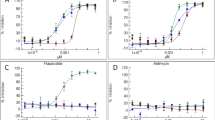Abstract
Fusarium species cause dry rot or seedpiece decay of potato tubers in storage and in the field. When potato storages were sampled in the Columbia Basin of Oregon and Washington,F. sambucinum, F. oxysporum, andF. solani were the predominantFusarium species recovered from potato tubers with dry rot. OtherFusarium species recovered includedF. avenaceum, F. culmorum, F. equiseti, F. proliferatum, andF. sporotrichioides. The majority ofF. sambucinum isolates tested were resistant to thiabendazole at 5, 10, and 25 mg liter-1 in amended potato dextrose agar (PDA), whereas resistance was less frequent inF. oxysporum andF. solani isolates. When isolates ofF. sambucinum, F. solani, andF. oxysporum were grown on PDA with no thiabendazole, the average colony diameter of isolates with resistance to thiabendazole was greater than the average colony diameter of isolates sensitive to thiabendazole for each respective species. When isolates ofF. sambucinum were placed on tuber slices, lesions were apparent by four days after inoculation, and lesion diameters were generally greater than those associated withF. solani orF. oxysporum. At eight days after inoculation onto tuber slices, the average lesion diameter ofF. sambucinum, F. solani, orF. oxysporum isolates with resistance to thiabendazole was greater than the average lesion diameter of isolates sensitive to thiabendazole for each respective species. Thiabendazole-resistance was also detected inF. avenaceum, F. culmorum, F. equiseti, andF. sporotrichioides.
Resumen
Las especies deFusarium causan pudrición seca del tubérculo de papa o pudriciones en el almacén y el campo. Cuando se hizo un muestreo en la Cuenca Columbia de Oregon y Washington,F. sambucinum, F. oxysporum yF. solani fueron las especies predominates extraídas de tubérculos de papa con pudrición seca. Otras especies extraídas incluyeronF. avenaceum, F. culmorum, F. equiseti, F. proliferatum yF. sporotrichioides. La mayoría de aislamientos probados deF. sambucinum fueron resistentes al thiabendazole en a 5, 10 y 25mg/L-1 en papa-dextrosa-agar (PDA) modificado, mientras que la resistencia fue menos frecuente en aislamientos deF. oxysporum yF. solani. Cuando se sembraron aislamientos deF. sambucinum, F. solani yF. oxysporum en PDA sin thiabendazole, el diámetro promedio de la colonia de los aislamientos con resistencia a thiabendazole fue mayor que el diámetro promedio de los aislamientos sensibles al thiabendazole para la especie respectiva. Cuando los aislamientos deF. sambucinum fueron colocados en rodajas de tubérculo, las lesiones fueron visibles cuatro días después de la inoculación y el diámetro de las lesiones fue mayor que aquel asociado conF. solani o conF. oxysporum. A los ocho de la inoculación en rodajas, el diámetro promedio de la lesión de los aislamientos deF. sambucinum, F. solani oF. oxysporum con resistencia a thiabendazole fue mayor que el diámetro promedio de los aislamientos sensibles a este producto para cada especie. También se detectó resistencia al thiabendazole enF. avenaceum, F. culmorum, F. equiseti yF. sporotrichioides.
Similar content being viewed by others
Literature Cited
Ali S, VV Rivera and GA Secor. 2005. First report ofFusarium graminearum causing dry rot of potato in North Dakota. Plant Dis 89:105.
Ayers GW and GC Ramsay. 1961. Epidemiology of Fusarium storage rot of potatoes in Prince Edward Island. Can Plant Dis Surv 41:199–202.
Boyd AEW. 1972. Potato storage diseases. Rev Plant Pathol 51: 297–321.
Desjardins AE. 1995. Population structure ofGibberella pulicaris (anamorphFusarium sambucinum) from potato tuber dry rot in North America and Europe. Am Potato J 72:145–156.
Desjardins AE, EA Christ-Harned, SP McCormick and GA Secor. 1993. Population structure and genetic analysis of field resistance to thiabendazole inGibberella pulicaris from potato tubers. Phytopathology 83:164–170.
Dhingra OD and JB Sinclair. 1985. Basic Plant Pathology Methods. CRC Press, Boca Raton, FL.
Hanson LE, SJ Schwager and R Loria. 1996. Sensitivity to thiabendazole inFusarium species associated with dry rot of potato. Phytopathology 86:378–384.
Hide GA, PJ Read and SM Hall. 1992. Resistance to thiabendazole inFusarium species isolated from potato tubers affected by dry rot. Plant Pathol 41:745–748.
Kawchuk LM, JD Holley, DR Lynch and RM Clear. 1994. Resistance to thiabendazole and thiophanate-methyl in Canadian isolates ofFusarium sambucinum andHelminthosporium solani. Am Potato J 71:185–192.
Kommedahl T, CE Windels and RE Stucker. 1979. Occurrence ofFusarium species in roots and stalks of symptomless corn plants during the growing season. Phytopathology 69:961–966.
Leach SS. 1985. Contamination of soil and transmission of seedborne potato dry rot fungi (Fusarium spp.) to progeny tubers. Am Potato J 62:129–136.
Nash SM and WC Snyder. 1962. Quantitative estimations by plate counts of propagules of the bean root rotFusarium in field soils. Phytopathology 52:567–572.
Nelson PE, TA Toussoun and WFO Marasas. 1983.Fusarium Species, an Illustrated Manual for Identification. Pennsylvania State University Press, University Park, PA.
Peters RD, IK Macdonald and KA Maclsaac. 2001. First report of thiabendazole-resistant isolates ofFusarium sambucinum infecting stored potatoes in Nova Scotia, Canada. Plant Dis 85:1030.
Ray H and R Hammerschmidt. 1998. Responses of potato tuber to infection byFusarium sambucinum. Phys Mol Plant Pathology 53:81–92.
Rowe RC (ed). 1993. Potato Health Management. APA Press, St. Paul, MN. pp 1–178.
Secor G, N Gudmestad and DA Preston. 1991. How to combat Fusarium dry rot. Valley Potato Grower 57:20–21.
Secor GA and B Salas. 2001. Fusarium dry rot and Fusarium wilt.In: WR Stevenson et al. (eds), Compendium of Potato Diseases, 2nd edition. APS Press, St. Paul, MN. p 144.
Staub T. 1991. Fungicide resistance: Practical experience with antiresistance strategies and the role of integrated use. Annual Rev Phytopathol 29:421–442.
Tivoli B, A Deltour, D Molet, P Bedin and B Jouan. 1986. Mise en evidence de souches deFusarium roseum varsambinum resistantes au thiabendazole, isolees a partir de tubercules de pomme de terre. Agronomie 6:219–224.
Tuite J. 1969. Plant Pathological Methods; Fungi and Bacteria Burgess Pub. Co., Minneapolis, MN.
Author information
Authors and Affiliations
Corresponding author
Rights and permissions
About this article
Cite this article
Ocamb, C.M., Hamm, P.B. & Johnson, D.A. Benzimidazole resistance offusarium species recovered from potatoes with dry rot from storages located in the Columbia basin of oregon and Washington. Amer J of Potato Res 84, 169–177 (2007). https://doi.org/10.1007/BF02987140
Accepted:
Issue Date:
DOI: https://doi.org/10.1007/BF02987140




